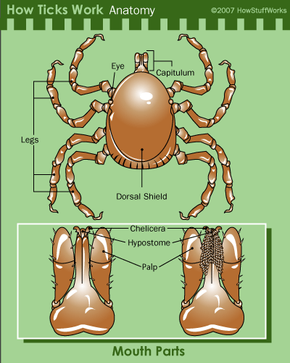Quck answer
Ticks are small arachnids that feed on the blood of animals and humans, and can transmit diseases such as Lyme disease and Rocky Mountain spotted fever. They have specialized mouthparts that allow them to attach to their host and feed for several days. Ticks go through four stages of development, and each stage requires a blood meal to progress to the next stage. They are most active during warm months and are commonly found in wooded and grassy areas. Preventing tick bites and promptly removing attached ticks can help reduce the risk of tick-borne illnesses.
Wild Animals
Anatomy of a Tick

Though often categorized with insects that suck blood, ticks are actually arachnids with four pairs of legs. Their small, flat bodies make it easy for them to attach to a host and feed undetected. Adult ticks have eight legs covered in spiny hairs and claws, which help them grasp vegetation and hosts. Ticks use their mouthparts to pierce the host’s skin and extract blood. The mouthparts include two palps, two chelicerae, and a barbed hypostome. As ticks feed, their body expands, with female hard ticks swelling immensely to store blood for laying eggs.
Adaptations for Survival

A lone star tick nymph
Photo courtesy CDC/Dr. Amanda Loftis, Dr. William Nicholson, Dr. Will Reeves, Dr. Chris Paddock
Ticks have adapted to blend in with their hosts, with some species, like the Aponomma komodoense, almost indistinguishable from their host’s scales. Many ticks must stay attached to their host for a day or more to finish a meal, so their ability to go unnoticed is crucial for survival. Some ticks secrete a cement-like substance with their saliva, making it harder to remove them without damaging the skin. Unlike flea saliva, tick saliva rarely causes itching and swelling.
Moving forward, we will delve deeper into the life cycles of ticks and analyze the contrast in feeding habits between hard and soft ticks. Essentially, ticks are parasites that solely rely on their hosts for survival. They possess a variety of adaptations that enable them to locate and consume the blood of their hosts.
FAQ
1. What are ticks?
Ticks are arachnids that belong to the family Ixodidae. They are parasitic and feed on the blood of mammals, birds, and reptiles. Ticks are common in wooded areas and can transmit diseases to their hosts, making them a potential health hazard.
2. How do ticks find their hosts?
Ticks find their hosts through a process called questing. They climb to the top of tall grass or shrubs and wait for a host to brush past. They then climb onto the host and attach themselves by inserting their mouthparts into the skin.
3. How do ticks feed?
Ticks feed by inserting their mouthparts into the skin of their host and sucking blood. They secrete a substance that prevents the host’s blood from clotting, allowing them to feed for several days. Once they are full, they drop off and find a place to lay their eggs.
4. What diseases can ticks transmit?
Ticks can transmit a variety of diseases to their hosts, including Lyme disease, Rocky Mountain spotted fever, and tick-borne encephalitis. These diseases can cause symptoms such as fever, headache, and joint pain, and can be serious if left untreated.
5. How can I protect myself from ticks?
To protect yourself from ticks, it is important to wear long sleeves and pants when walking in wooded areas. You should also use insect repellent that contains DEET and check yourself for ticks after spending time outdoors. If you find a tick, you should remove it promptly to reduce your risk of contracting a disease.
6. How do I remove a tick?
To remove a tick, use fine-tipped tweezers to grasp the tick as close to the skin’s surface as possible. Pull upward with steady, even pressure until the tick releases its hold. Do not twist or jerk the tick, as this can cause the mouthparts to break off and remain in the skin.
7. Can ticks live indoors?
While ticks are typically found outdoors, they can sometimes make their way indoors on pets or clothing. It is important to check your pets for ticks after they have been outside and to wash your clothing in hot water to kill any ticks that may be present.
8. What should I do if I find a tick on my pet?
If you find a tick on your pet, use fine-tipped tweezers to remove it as soon as possible. You should also monitor your pet for signs of illness, such as fever or lethargy, and contact your veterinarian if you notice any unusual symptoms.
9. Are ticks more active at certain times of the year?
Ticks are most active during the warmer months, typically from April to September. However, they can be active year-round in warmer climates. It is important to take precautions against ticks whenever you spend time outdoors.
10. Can I get Lyme disease from a tick bite?
Yes, Lyme disease is a bacterial infection that can be transmitted through the bite of an infected tick. If you develop a rash or other symptoms after being bitten by a tick, you should contact your healthcare provider for evaluation and treatment.





Leave a Reply